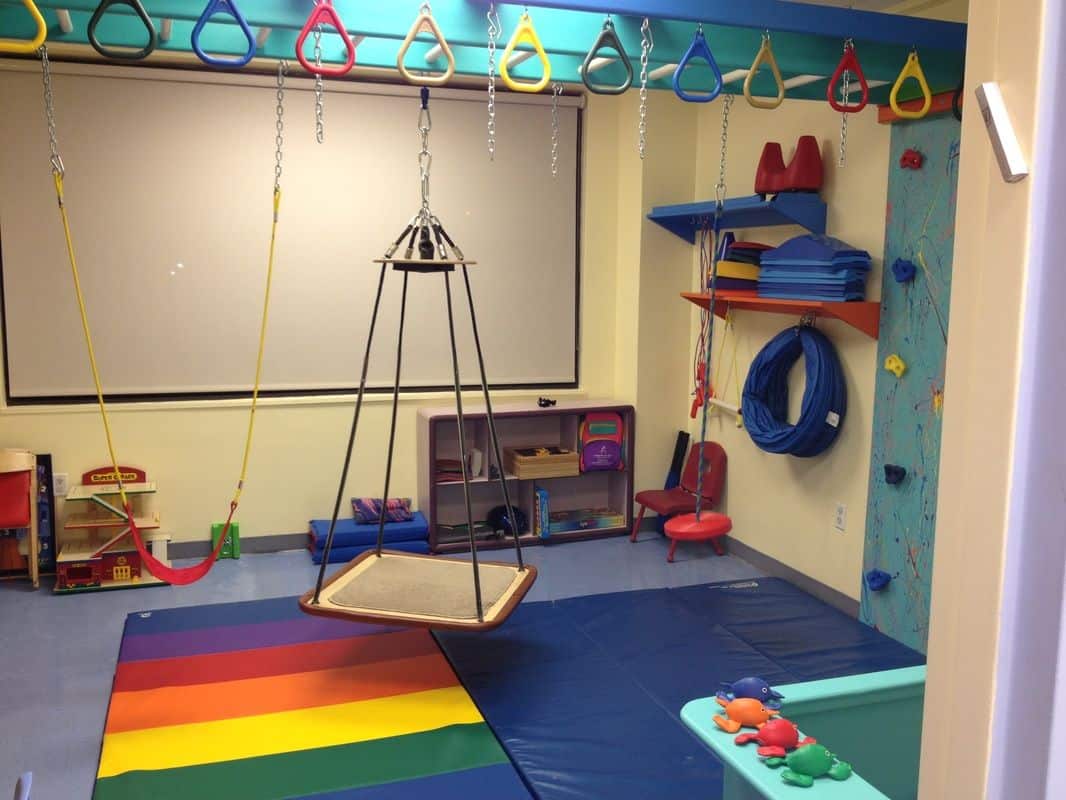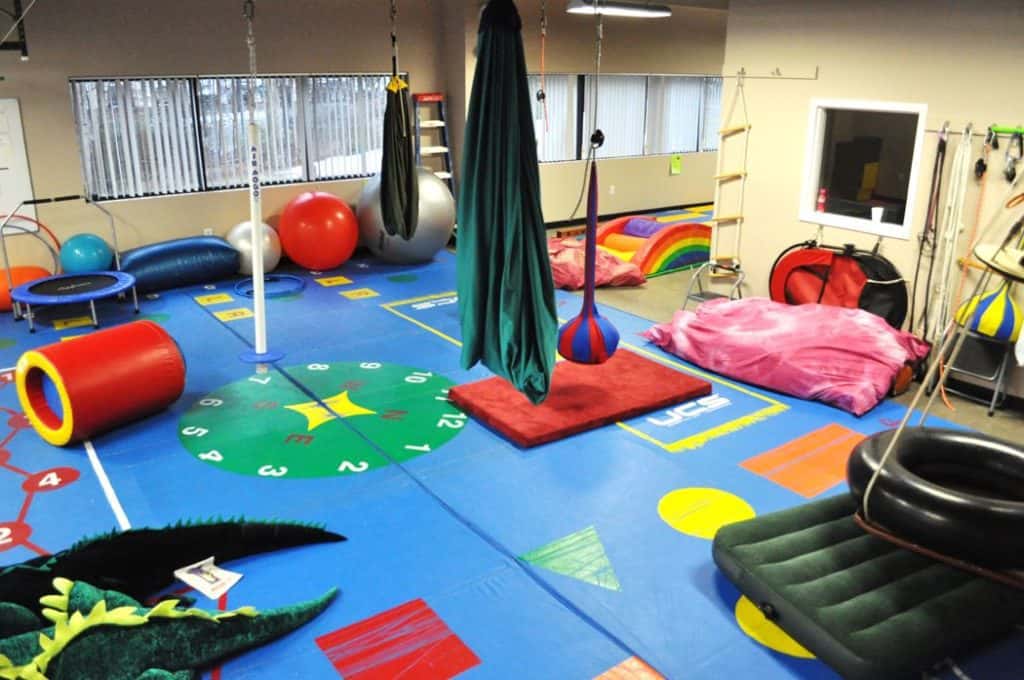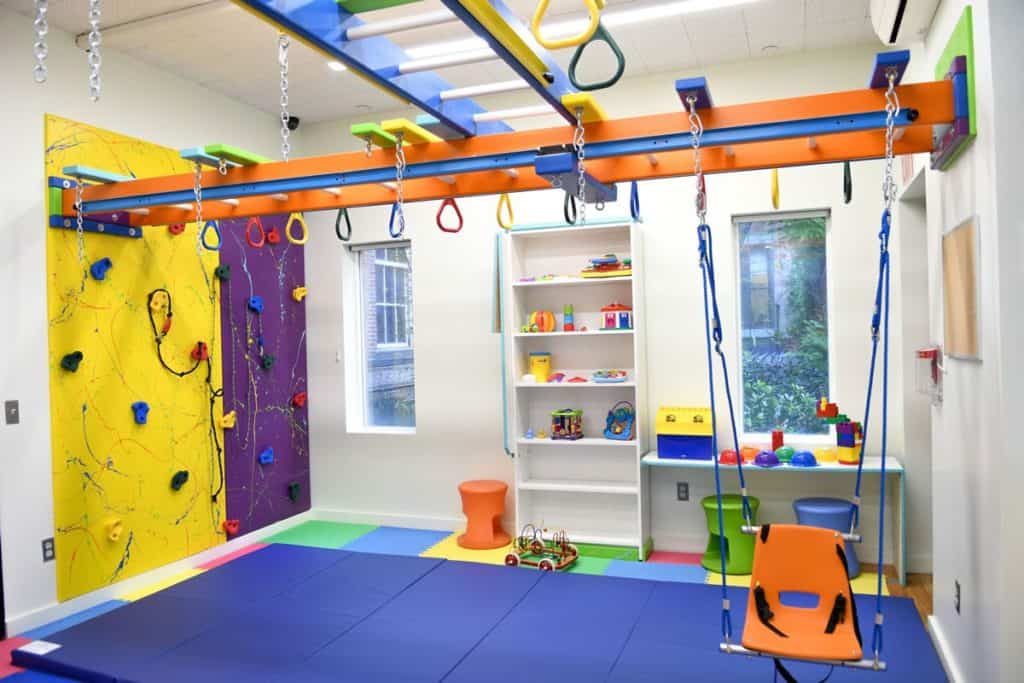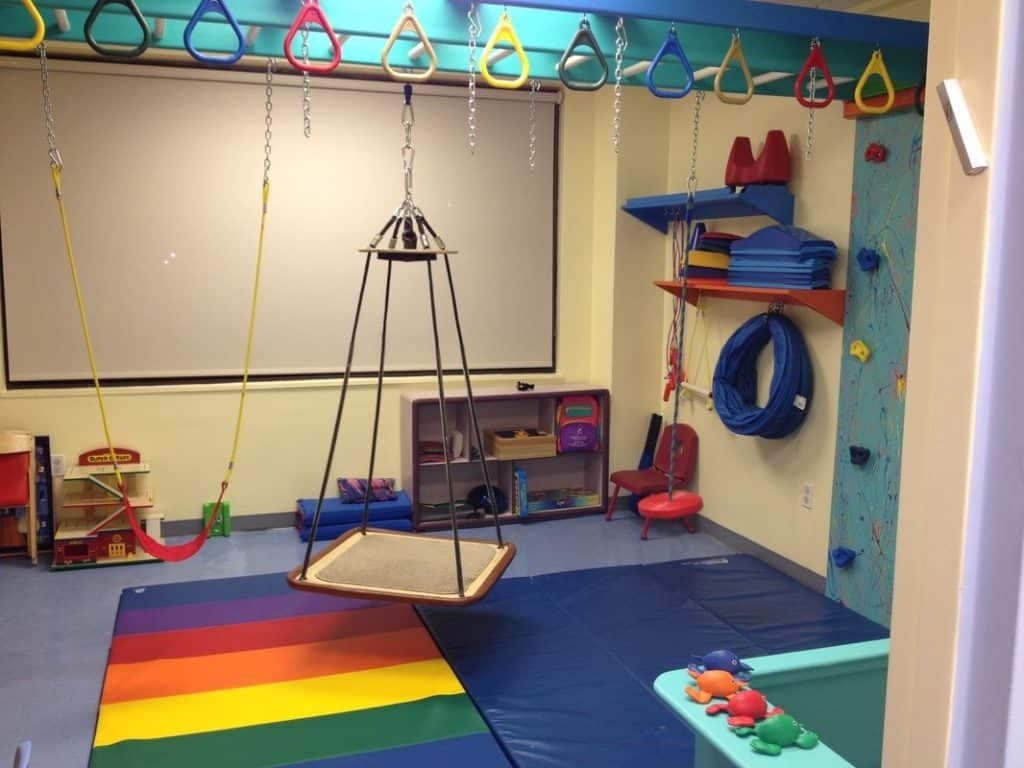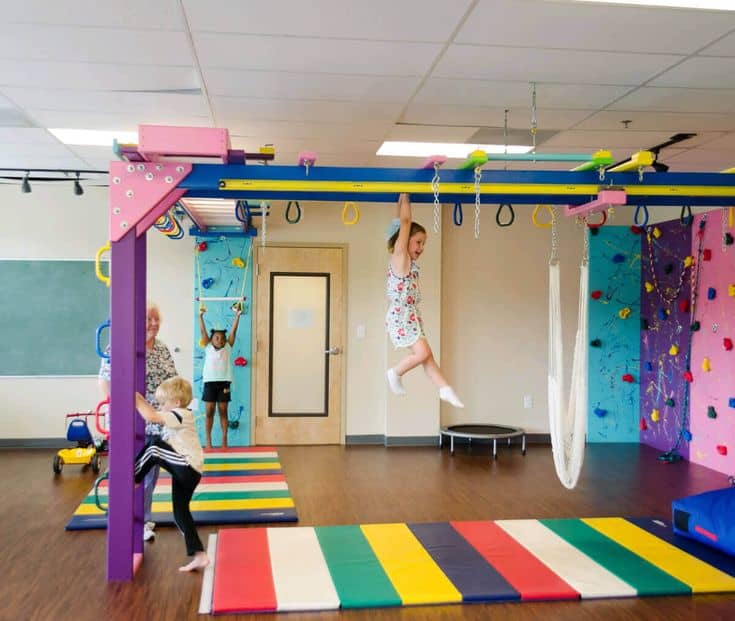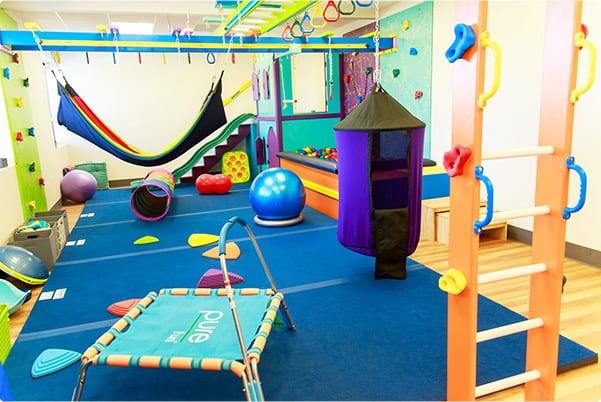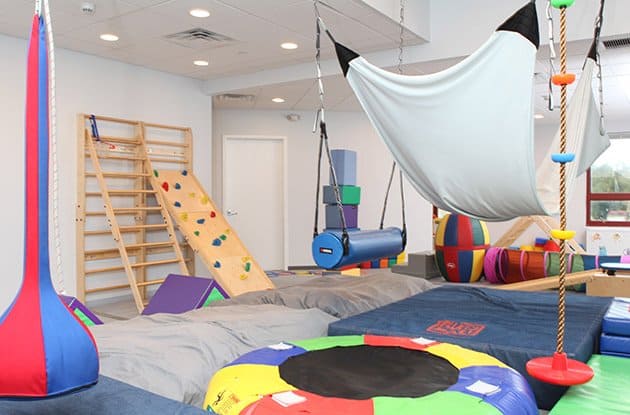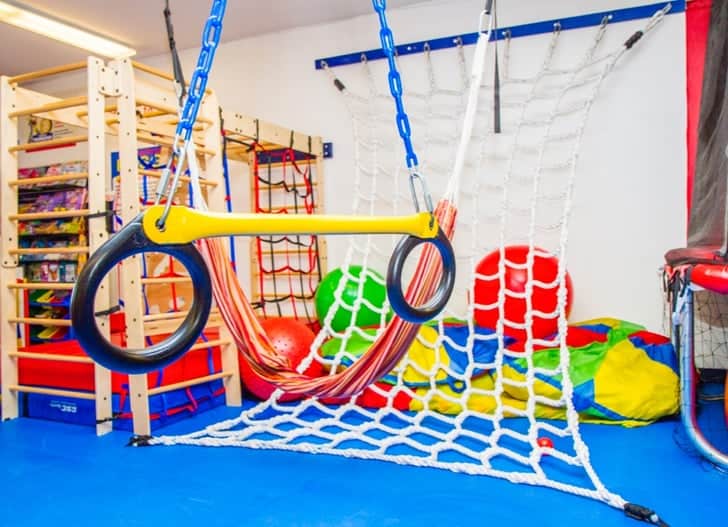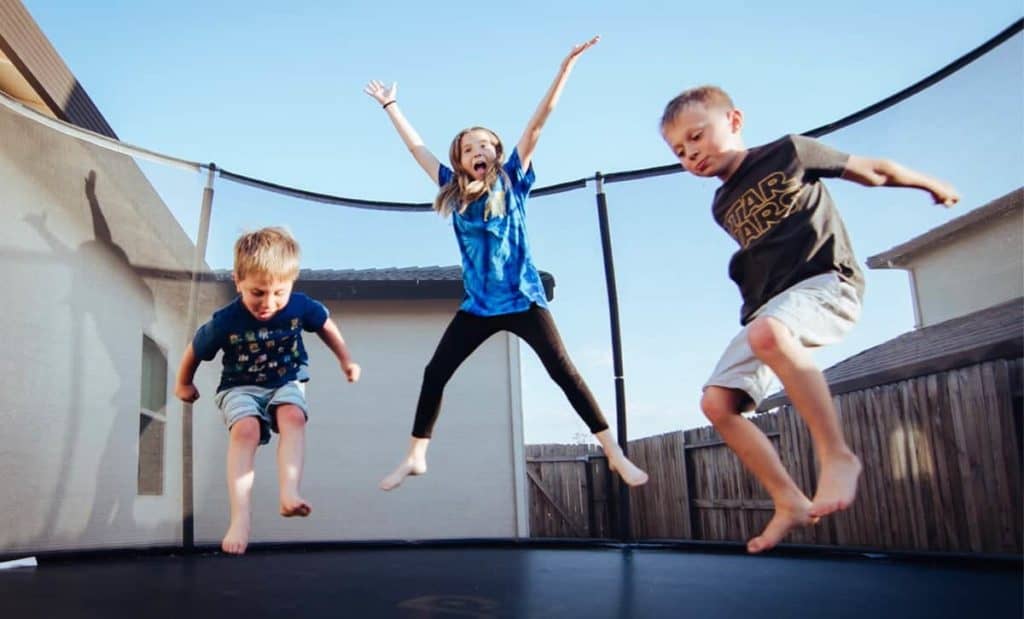A sensory room is basically a sensory area in a gym setting. It is heavy on movement and other kinesthetic equipment. A sensory area has many items that stimulate the senses. It is extremely beneficial for children with sensory processing disorders.
Staying indoors is no excuse!
The outdoors is better than any sensory room. Fresh air and sunlight are great for your child’s health. You can find out more about how to improve your child’s outdoor sensory experiences by reading my post on kids’ fitness.
I’ve known children who have difficulty coping with the outdoors due to their sensitivities. However, that doesn’t mean they aren’t enjoying the benefits. You can take them outside in the mornings or evenings if they are sensitive to the sun. Wear soft-soled shoes, socks, or walk on grass that is safe for them if the ground or grass irritates. You can modify your child’s outdoor activities as necessary, but don’t take them away. Remember to offer sensory experiences outdoors.
The Importance and Benefits of Sensory Play and Sensory Gym
Play is the best way for children to learn.
In fact, play plays (no pun intended!) Play is an important part of learning, regardless of age.
Play is encouraged in children for many reasons.
- This gives your child the freedom to choose what he or she likes based on current interests.
- It’s always fun and enjoyable.
- It is spontaneous.
- It creates imagination.
- It is motivated by intrinsic motivation to help children discover their potential.
- It is one of the most effective learning methods in a safe environment.
- Play allows children to explore new ideas and try out new things.
Professor Doris Fromberg is the Director of Early Childhood Teacher Education at Hofstra University. She spoke about play and how it can be the key to ” pulling together the creative and logical parts of the brain.
It is important to fine-tune motor skills even in the simplest activities, such as running, jumping, and climbing up slides, or dancing. It helps with muscle development.
Their emotions are also stimulated and controlled through play. And sensory stimulation is very effective. This helps to build and improve their social life skills.
Having said that, children should have a sense of adventure and imagination through play to develop their whole being.
Individualized Sensory Gym Ideas
Space
It is entirely up to you and the size of your home how much space you want to use. If your basement has a lot of space, it is a great choice. This is the best place to turn your spare bedroom or playroom into a sensory room. One room is used as our family’s sleeping area. We also transformed the bedroom of our children into a sensory room and gym. You can use the bedroom your child sleeps in as their sensory room, but make sure it is still calm and quiet. This is can help to keep your child calm too.
Your sensory room should be located in an area that has high ceilings if possible. This will make it easier to jump toys and build climbing equipment.
Do you have a small space? No worries! We lived in a tiny apartment when I had my first baby. My son’s sensory room was created by me. Instead of placing a table in our tiny dining area, I placed a gymnastics mat. You can hang sheets, tents or curtains indoors if you don’t have enough space. Or, clear out your closet and make a special area for your child.
You can also read about how to make space if you don’t believe you have here.
Flooring
Hard floors are easier to maintain, but they can also be more easily damaged if you fall on them. Hard flooring is my preference in sensory rooms, as carpet attracts dirt and germs. It’s also nice to have a smooth, even surface for rolling, sliding, and other activities.
It’s easy to put padding on hard floors. Gymnastics mats are my preferred choice because they can withstand kids’ wear and tear and are easy to clean. Here’s a breakdown of the best gymnastics mats for your home. They are durable, versatile, and have a high resale price.
To make it more comfortable to sit on the floor, you can choose to purchase a large rug or blanket for your room.
I’ve seen many interlocking foam floor tiles similar to this for sensory room floors. This flooring option is affordable. It should not be used as a protective mat for children who are climbing, hanging, or jumping from elevated surfaces. Gymnastics mats should be used for landing, as children with special needs may have difficulty landing or falling. Interlocking mats also get filthy and age quickly. Some people may enjoy the ability to tear or chew this flooring.
Common Misconceptions
One common misconception about sensory gyms is that they have a limit on their age.
This is the truth:
Play is essential for all ages and walks of life.
All ages are encouraged “to play” to keep their minds and bodies active.
You can pat yourself on the back and say “You’re never too old or too young to play!”
Sensory gyms can be even more beneficial for children and adults with sensory disabilities.
Most people mistake sensory gyms for traditional health and fitness clubs.
However, the sensory gyms you visit will have brightly colored walls and child-friendly stations that are far from what you want.
Sensory gyms are now available in only two places: hospitals and physical therapy centers for people with disabilities.
There are now independent franchises such as Special Strong that provide sensory training for people with disabilities. This includes those with ADHD, autism spectrum disorder, or ASD.
You might be wondering what “sensory disorder” could mean.
Sensory processing disorders, by definition, are conditions in which the brain has trouble receiving and responding.
These are just a few examples of sensory disorders:
- Always bumping into things
- Sensitivity towards loud noises and light
- Feeling itchy with certain fabric textures
- Avoidance of touch from humans
- Unresponsiveness
Sensory disorders are often a symptom or complication of another condition like ADHD, attention deficit hyperactivity disorder, autism, or attention deficit hyperactivity disorder.
Children will sometimes dive under the table if they hear loud noises. Some children are afraid of certain textures. Some people are picky about certain textures. Some people will keep putting things in their mouths. Some people don’t like being touched or hugged. Some people seem to be unable to respond to cold or heat. Some people seem to be immune to pain.
The Eight Senses
The five senses are well-known to you. It’s likely that you learned it in school.
Sight, Hearing, Taste, and Opinion are the five common senses. Touch is the fifth.
Sensory integration involves three senses. These three senses are the vestibular and interoception, as well as the proprioception.
Your body’s posture and balance is maintained by the vestibular sensor. It is best known as the balance center of your entire body. This sense allows you to glide down a slide or ride a skateboard without feeling disoriented.
The Proprioception sense is very similar to the vestibular sense. This sense only informs you of your body’s location in space. This is the position sensor, which allows you to touch your nose and ears even when your eyes are closed. This sense allows you to walk and not look at your feet in order to determine if they are moving.
The interoception feeling is last. This sense is less well-known because it involves your body’s self regulation. This sense is responsible for feeling cold, hungry, itchy, or in pain. This is the internal signal that lets you know what’s happening inside of your body and tells you how to respond.
Sensory disorders can be a symptom of ADHD and autism, as you’ve read. To keep their mind and body alert and focused, children with sensory disorders should be encouraged to consume sensory food.
Sensory gyms are a great option. Sensory gyms are equipped with the right equipment so that children, teens, and adults can all benefit from a sensory diet. These activities are designed to help people with sensory input.
Here are more reasons why a sensory gym might be a good idea for children with autism or ADHD.
Sensory Room Equipment For Each Sense
Sensory room equipment is equipment that stimulates or calms the senses. Most sensory room equipment focuses on touch, sight, hearing, and kinesthesia. When deciding what sensory items to add, consider whether your child has sensory delays, problems with sensory seekers. Certain sensory experiences or too many can overwhelm some children.
I have categorized the equipment in categories that correspond to which sense they stimulate best. This is a quick list of items that you might consider adding to your own sensory gym.
An Easy Guide to Sensory Equipment For Room – Organized by Each Sense!
Touch
This is what most tutorials on the internet seem to be focusing on when it comes to sensory toys. You can find a lot of DIY sensory toys on Pinterest. You and your child will choose the one that you like best.
Touch is more than just for your hands. You also need to touch your feet, even though they are often covered in shoes. For a path to walk on, place large flat stones. Or fill a shallow container with stones and marbles for children to step in. It’s amazing to feel the lamb’s wool in a child’s room. Many are fake or highly processed, but you can still get real lambskin for your child
Sight
Books and pictures are obvious choices for the senses of sight. It is easier to read books if they are lower than the rest and on a rotating display. These are some great book suggestions for kids.
Mirrors are essential! Mirrors are a must for babies, toddlers, as well as children. They can also be used to view themselves and perform tricks. The mirrors can be cleaned with wipe-away markers, which is also a favorite of older children.
Bubbles and bubble makers are great for eye tracking and hand-eye coordination. Mobiles can also be used for this purpose.
Another great sensory experience is lighting. Lava lamps can be relaxing and emit a soft glow. String lights, such as Christmas lights, can be simple to add magic and charm to a room. They are inexpensive and simple to use. Kids love to create shadows on the walls with flashlights, or even go under blankets for light shows.
Auditory
Every child should have a musical instrument in their playroom. You can make simple instruments, such as rattles from bottles or sticks that you tap together.
I recommend that you invest in quality instruments to help your child learn tunes.
Six years ago, I purchased a children’s gathering drum. It has survived being pounded, stepped on, and otherwise abuse. You can see the one that we have. The 22″ is the one we have. I bought it for our homeschool coop. However, I believe the smaller version would be more suitable for the home.
My children love their keyboard, and they use it almost every day! It can play many tunes and they love to use it. It can be set to play at different speeds, such as fast, slow, or loud. Casio is a brand we offer that isn’t a toy for kids, but a keyboard. It’s affordable and simple to use for children. There are two sizes available (we have one of the larger ones) and there are great reviews. You can check the current price.
Many children love having a music player or a music box in their rooms.
Movement
Our kinesthetic sense is often overlooked. It is our sense to balance and know where we are in space or our body position. We also know how to move our bodies to achieve what we want. With all the distractions of life and the popularity swings and infant seats as well as other devices that prevent babies from moving in the way their bodies are designed, it has become more difficult to promote kinesthesia in children.
Motor delays are more common in children born prematurely, but it is less common for them to be treated. One of the best playroom ideas is to give toddlers more movement opportunities.
Consider allowing the sensory room equipment to move in a variety of ways. For example, up, down, side-to-side, back and forth, etc. Each muscle group should be used.
Hanging
Hanging with your child will help strengthen their upper body, and increase their willingness to take risks. Hanging playground swinging bars with hooks can be done easily by screwing hooks into the ceiling. Although pull up bars attach to and unattach easily to door frames are great, they can be too high for small children to reach. Every day, my kids use our home gymnastics bar. You can encourage climbing by hanging a rope from the ceiling.
Swinging
A sensory swing is a popular option for autistic people. However, swinging can be beneficial for anyone. It is difficult to replicate the movement of a swing without equipment. While rocking chairs can give you the same feeling as swinging, they are easy to put together. Rocking horses, on the other hand, are much more difficult to use. The horse can also be rocked to increase their strength.
Traditional hammocks are my favorite because they allow the user to wrap up and swing while also allowing them to lay down or sit. There is often no place on your ceiling where you can hang hooks, but hammocks allow you to use the walls. Hammocks Rada is a great brand. I have two. You can view a variety of sizes and colors.
Bouncing
Around two years of age, children can start to jump with their feet together. Children with delays often can’t leap with their feet together until they are much older.
Many children can jump with their feet only if they are given a trampoline or other bouncy surface. Mini trampolines can be a fun way to encourage jumping and make a great piece of sensory gym equipment.
This one is ours. It was purchased 3 years ago after the previous one had broken. It doesn’t have springs that can cause fingers to be pinched, it can withstand jumping on it (and occasionally using it in my gymnastics classes), as well as being a reasonable price.
Two reasons are why I don’t recommend kids trampolines that have bars to hold onto for jumping: The bars are dangerous as children can fall on them, especially if they jump on their knees. They also take away some of the joy of jumping – children should use all of their bodies to jump. However, holding onto a bar reduces their torso’s burden, making it unnatural.
You can also use yoga therapy balls to add bouncing in your toddler’s playroom. They are super fun!
Climbing
It is possible to incorporate climbing into a sensory gym. To climb up, placemats or pillows in the middle. To make a rock climbing wall, attach climbing ropes or climbing holds to the wall. My kids loved climbing up the rope ladder that we built.
The gymnastics cheese mat is a great piece of climbing equipment that can be used by younger children and pre-walkers.
Conclusion
A sensory gym can provide many benefits. You could help your child improve their sensory integration by building a sensory gym. You can make sure your sensory gym is tailored to your child’s needs.
Your child is your best friend. If you can do this, you’ll soon be able to give them the best learning experience. It is a great way to strengthen the relationship you have with your child and to learn more about their condition.
F.A.Q.
What is a sensory gym for?
The Sensory Gym allows for active sensory play. Sensory equipment is used to provide vestibular and proprioceptive sensory input. This includes swings, trampolines, therapy balls, and other such items.
How do you make a sensory gym at home?
These are some items you might consider including in your sensory room:
1. Mats or large crash pillows.
2. Bean bag chair.
3. Socks for the body
4. A net swing, or therapy sensory swing.
5. You can use your fidget item to create a repetition of a moment.
What is a sensory gym for?
Children can improve their sensory processing by spending time in a sensory room. Sensory rooms provide calm and comfort to help children self-regulate their behavior, which in turn improves focus.

